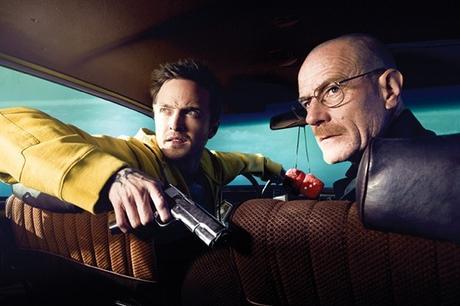
The characters of Breaking Bad have different goals…this creates conflict!
If you’ve been following along with my NaNoPlotMo method of plotting, or even if you haven’t, eventually you have to write the scenes. Be excited! This is the fruition of your labor. Now you’re free to create without fear of missing some key story element.
If you have generated story beats from each character’s goals, your next move is combine those beats into scene. One or two beats for each scene is optimal. More may get confusing. Let’s go right to an example for this one:
Your character Bob has a goal of asking Carol on a date. Your beat #1 says he’ll seek advice. Let’s pick Bob’s lady-killing friend, Tom.
So now Tom’s in the scene because he’s the best candidate for advice about women. Now Tom has several goals as well, one of which is to become a professional hit man. Let’s say we’re all the way up to beat #3 of Tom’s career aspiration. This is where he meets his first client and gets and assignment.
Okay, now a setting for our scene. Bob could call Tom on the phone. Boring (notice they don’t use this much in the movies). Bob could go to Tom’s apartment, but it seems unlikely Tom would meet his client there. A lot depends on genre. If this were a serious suspense, we’d pick someplace quiet and hidden. Maybe a park or dark bar. But I think I’ll make this a romantic comedy. So we’ll go with the cliche. An Italian restaurant. We can throw in a funny waiter to spice it up even more.
So Bob just happens up Tom in an Italian restaurant. Tom, of course, doesn’t want company, but Bob is insistent.
What do have here? That’s right! Conflict.
Conflict…your key to writerly glory!
Conflict is the writer’s best friend. Have it in every scene, even if it’s mild conflict. In our example scene, we have Tom waiting on his client to set up his first hit. But then we have Bob barging in and begging Tom’s advice. Each character has a goal. Each character is being denied his goal by the other. Conflict. Eat it up.
This is why we spent all that time coming up with character goals and story beats. We can arrange the beats like game pieces and come up with these ideal scenes. If a scene doesn’t work, re-arrange some beats to see if you can make it better.
Second that Emotion
The second Essential Scene Element is emotional change. At least the POV character should end the scene in a different emotional state than when he began. Bob will start out hopeful, but end up discouraged because Tom is not interested in his problems. Tom will start out excited, maybe a bit nervous, but he’ll end up angry and frustrated when his client turns around and walks out when he sees that Tom is not alone.
Whether you’re using index cards or a blank page, write at the top or bottom of each scene this:
Conflict – Character A wants X but is denied it by B.
Emotional Change – Character A starts out X but ends up Y.
Remember, the emotional change can be in the positive or negative direction. Unless you’re writing a French film, you’ll want some upbeat scenes as well.
Okay? There’s more to writing scenes, of course, and we’ll get into that as well. But start off with these two essentials, and your readers will come back for more!
